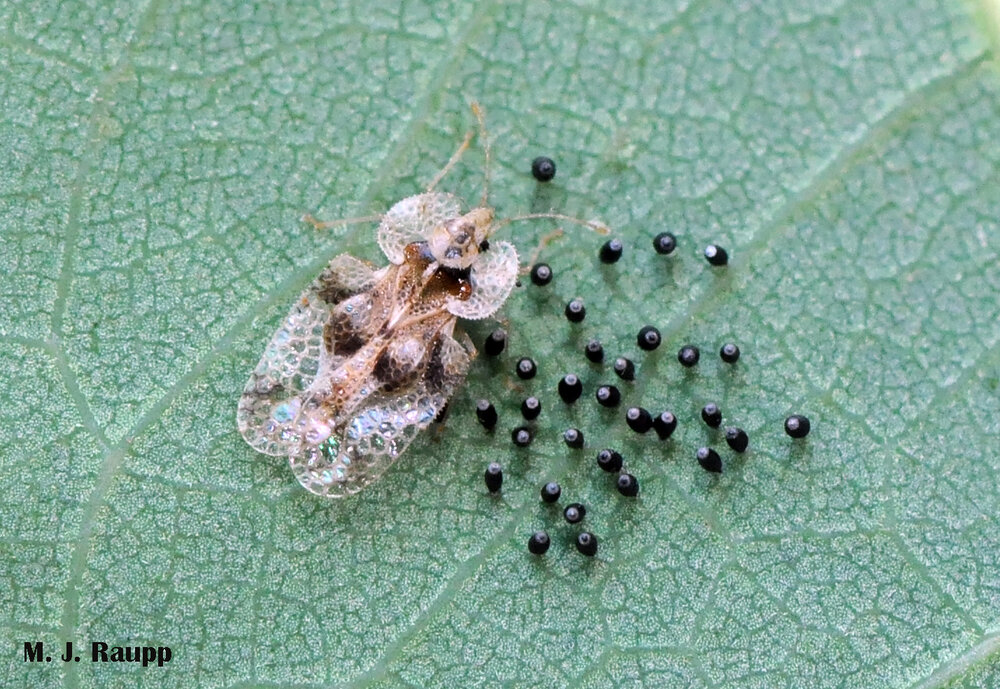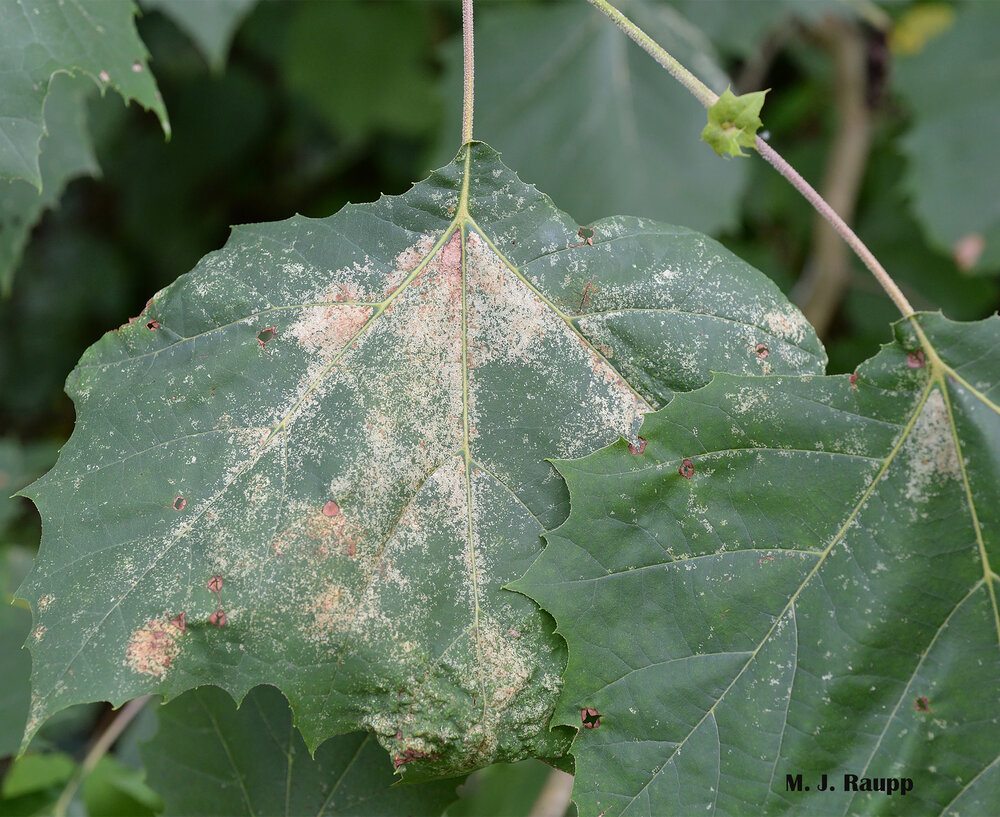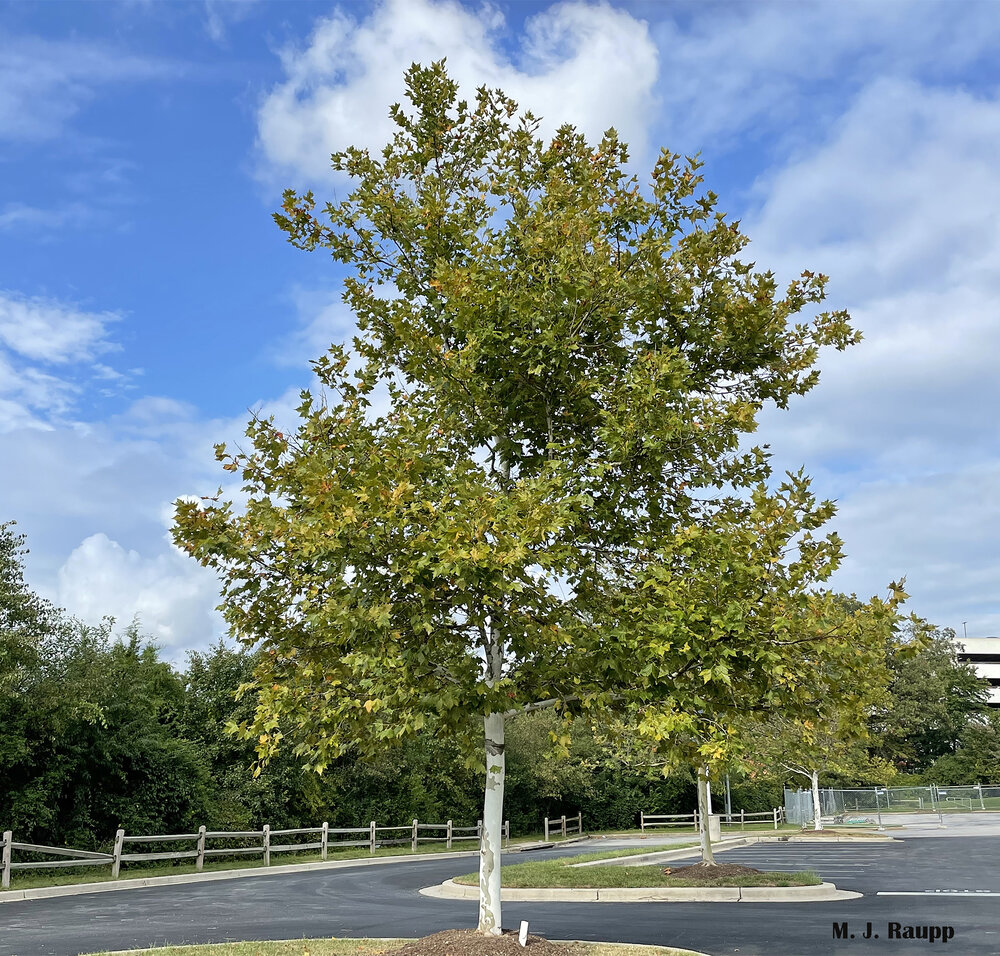Lace bugs help put the “sick” in sycamore: Sycamore lace bug, Corythucha ciliata

A beautiful sycamore lace bug seems to stand guard near her recently laid clutch of eggs.
American sycamore is a magnificent native tree often found growing along streams and rivers. Although it thrives in rich, moist soils, its ability to survive stressful environmental conditions such as poor soils, drought, heat, and pollution has earned sycamore a valued place in cities and residential landscapes worldwide. Here in the DMV by the middle of summer and reliably by the month of October, some sycamores just look sick. Their leaves have turned from verdant green to anemic yellow. This is not just the work of Mother Nature signaling the tree to prepare for winter. Since late spring, many sycamores have had the life sucked out of them by thousands of tiny sap-sucking insects called sycamore lace bugs. We met relatives of the sycamore lace bug in a previous episode of Bug of the Week called “And may all your azaleas be white.”

Oh my, hundreds of sycamore lace bug feeding punctures on the bottom of a leaf translate into a galaxy of white stipples on the upper surface of a leaf.
One leafy subject I examined this week had more than 200 lace bug eggs, nymphs, and adults on the undersides of several of its leaves. Beautiful but pernicious is the adult lace bug. Delicate outermost wings with numerous lacey veins give this bug its common name. And these wings are not just adornment. They can be tilted like a shield to ward off attacks by would-be predators like lacewing larvae or ladybugs. As autumn ends, adult lace bugs find protected places beneath bark or debris on the ground to spend the winter. In spring shortly after new leaves are formed, they return to the foliage and attach small black barrel-shaped eggs onto the leaf’s surface. The highly fecund female can lay more than 200 eggs during the course of her lifetime. Tiny black nymphs festooned with rows of spines hatch from these eggs. Like their parents, lace bug nymphs have a beak used to rupture cells and withdraw nutritious liquid contents. The combined feeding of nymphs and adults results in many tiny white stipples visible on the upper leaf surface. The lower surface of the leaf is a mess of nymphs and adults, shed skins, eggs inserted into leaves, and dark fecal spots – the spoils of the ongoing feast. As numbers of lace bugs grow and successive generations feed on leaves, stipples increase and sometimes coalesce in a way that makes the entire leaf appear yellow or bronze.
White stipples on the upper leaf surface of sycamores may reveal adult sycamore lace bugs on the lower surface. Look for barrel-shaped eggs, spiny nymphs, shed skins, beautiful adults, and nasty tar-like fecal deposits left behind by lace bugs as they feed. Dense infestations may accelerate discoloration and early abscission of sycamore leaves.

Sycamores looking a little yellow and sick? Could be the mischief of sycamore lace bugs.
Lace bug development is temperature dependent and, as the world warms and our cities grow hotter, lace bugs may be able to complete more generations each year. If lace bugs and their damage are too great, the sycamore may simply drop its leaves and bring a premature end to the lace bug’s shenanigans. Other factors such as lack of nutrients or water may also cause sycamore leaves to turn yellow and fall, but one sure way to rule lace bugs out or in is to turn the leaves over and inspect them for the telltale signs of a lace bug infestation – lace bugs at all life stages, shed skins, and their fecal deposits. We often lament the fact that so many pests of our forests and gardens, like emerald ash borer, brown marmorated stink bug, and spotted lanternfly, arrived in North America from foreign lands. In the game of global economic tit for tat, our native sycamore lace bug is another example of a pest we have shared with other neighbors around the world, including more than three dozen nations in North America, Europe, Asia, and Oceana, where sycamores are widely planted and now regularly attacked by this insect.
Acknowledgements
We thank Veronica Robinson and John Neal for providing the inspiration for this episode. The interesting references “Corythucha ciliata (sycamore lace bug)” at the CABI website https://www.cabi.org/isc/datasheet/16264#tosummaryOfInvasiveness, and “Managing Insects and Mites on Woody Plants: an IPM Approach” by John Davidson and Michael Raupp, were used as references for this episode.
This post appeared first on Bug of the Week